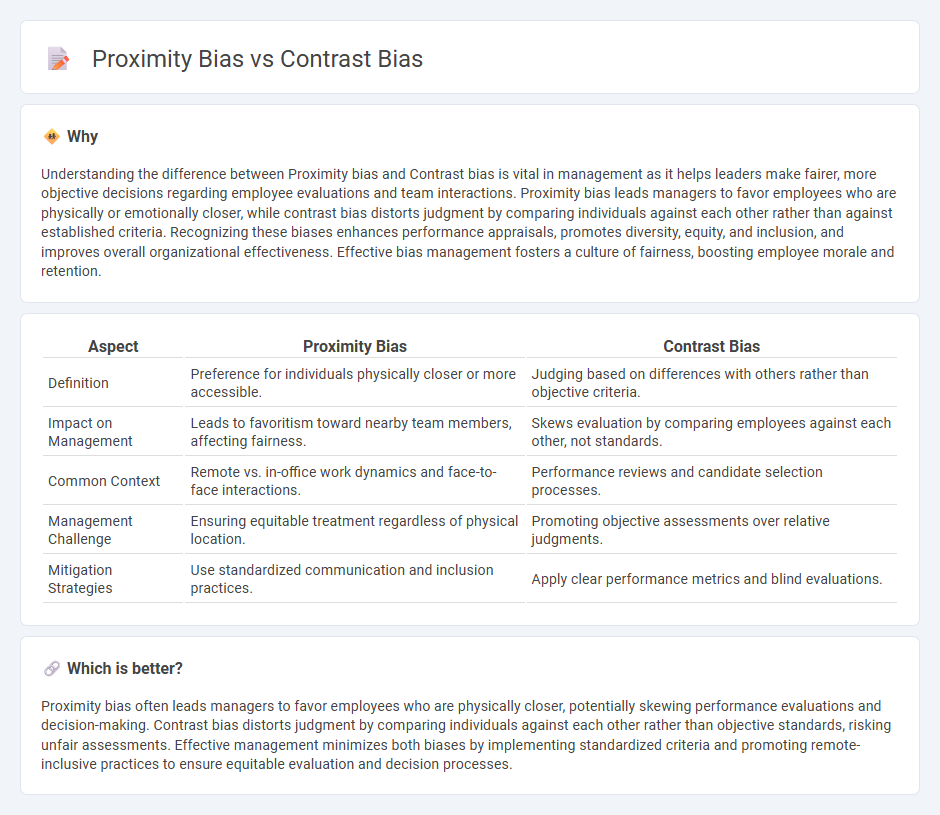
Proximity bias occurs when managers favor employees who are physically closer, affecting performance evaluations and team dynamics. Contrast bias involves unfairly comparing individuals against one another rather than assessing their independent merits, leading to skewed judgments. Explore the nuances of these biases to improve objective management practices.
Why it is important
Understanding the difference between Proximity bias and Contrast bias is vital in management as it helps leaders make fairer, more objective decisions regarding employee evaluations and team interactions. Proximity bias leads managers to favor employees who are physically or emotionally closer, while contrast bias distorts judgment by comparing individuals against each other rather than against established criteria. Recognizing these biases enhances performance appraisals, promotes diversity, equity, and inclusion, and improves overall organizational effectiveness. Effective bias management fosters a culture of fairness, boosting employee morale and retention.
Comparison Table
| Aspect | Proximity Bias | Contrast Bias |
|---|---|---|
| Definition | Preference for individuals physically closer or more accessible. | Judging based on differences with others rather than objective criteria. |
| Impact on Management | Leads to favoritism toward nearby team members, affecting fairness. | Skews evaluation by comparing employees against each other, not standards. |
| Common Context | Remote vs. in-office work dynamics and face-to-face interactions. | Performance reviews and candidate selection processes. |
| Management Challenge | Ensuring equitable treatment regardless of physical location. | Promoting objective assessments over relative judgments. |
| Mitigation Strategies | Use standardized communication and inclusion practices. | Apply clear performance metrics and blind evaluations. |
Which is better?
Proximity bias often leads managers to favor employees who are physically closer, potentially skewing performance evaluations and decision-making. Contrast bias distorts judgment by comparing individuals against each other rather than objective standards, risking unfair assessments. Effective management minimizes both biases by implementing standardized criteria and promoting remote-inclusive practices to ensure equitable evaluation and decision processes.
Connection
Proximity bias and contrast bias are interconnected cognitive phenomena that influence managerial decision-making and team dynamics. Proximity bias causes managers to favor employees physically closer to them, while contrast bias alters evaluations based on comparisons with other individuals rather than objective criteria. Both biases can lead to skewed performance assessments and unequal opportunities, highlighting the need for structured and unbiased management practices.
Key Terms
Evaluation
Contrast bias in evaluation occurs when an individual's performance is judged relative to others recently assessed, leading to skewed perceptions based on immediate comparisons rather than objective criteria. Proximity bias arises when evaluators favor employees who are physically closer or more visible, resulting in unequal assessments influenced by workplace location or interaction frequency. Explore further to understand strategies that mitigate these biases for fairer performance evaluations.
Perception
Contrast bias in perception occurs when individuals evaluate an object or person by comparing it to others, leading to exaggerated differences or similarities based on prior exposure. Proximity bias influences perception by favoring information or individuals closer in physical or relational distance, often causing an unrealistic assessment of their importance or abilities. Explore how these biases affect decision-making processes across various contexts for a deeper understanding.
Decision-making
Contrast bias distorts decision-making by comparing options against each other rather than evaluating them individually, often leading to skewed judgments favoring extremes. Proximity bias affects choices by prioritizing options or individuals that are physically or temporally closer, potentially overlooking more valuable but less accessible alternatives. Explore these cognitive biases further to enhance your decision-making accuracy and awareness.
Source and External Links
What Is Contrast Bias? - Critical Thinking - Contrast bias is a cognitive bias where people overemphasize differences between two or more things by comparing them directly rather than evaluating each independently, which skews judgment and perception based on relative differences instead of absolute qualities.
Understanding contrast bias in hiring, evaluation, HR practices and ... - This bias occurs unconsciously when evaluations are influenced by direct comparisons with others, leading to exaggerated perception of differences, especially in hiring or performance reviews, where subsequent candidates are judged relative to previous ones rather than on their own merit.
What Is Contrast Effect? And How It Impacts Recruitment - Applied - Contrast effect is an unconscious bias causing people to judge items or candidates relative to others rather than individually, resulting in either a positive or negative bias based on what is being compared, and it affects various judgment contexts including color perception and recruitment.
 dowidth.com
dowidth.com